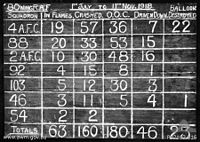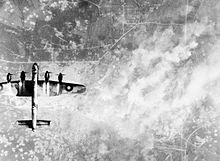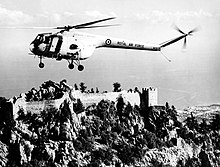No. 103 Squadron RAF
| No. 103 Squadron RAF | |
|---|---|
 | |
| Active | 1 Sep 1917 - 1 Oct 1919 10 Aug 1936 - 26 Nov 1945 30 Nov 1954 - 1 Aug 1956 1 Aug 1959 - 31 Jul 1963 1 Aug 1963 - 31 Jul 1975[1] |
| Country | |
| Branch | |
| Nickname(s) | "Swindon's 'own' Squadron" (unofficial)[2] |
| Motto(s) | Latin: Noli me tangere[2][3] (Translation: "Touch me not" or more modern: "Don't touch me") |
| Battle honours | Western Front, 1918* Hindenburg Line* France & Low Countries, 1939-40* Invasion Ports, 1940* Fortress Europe, 1940-44* Biscay Ports, 1941-43 Berlin, 1941-44* German Ports, 1941-45 Baltic, 1941-45 Ruhr, 1941-45* France & Germany, 1944-45* The honours marked with an asterisk(*) are those emblazoned on the squadron standard. |
| Insignia | |
| Squadron Badge heraldry | A swan, wings elevated and addorsed[3] A swan was chosen because this bird is very strong on the wing and also well able to defend itself[2] |
| Squadron Codes | GV (Apr 1939 - Sep 1939)[4][5] PM (Sep 1939 - Nov 1945)[6][7] |
No. 103 Squadron was a Royal Air Force bomber squadron during World War I, World War II and the Cold War, switching to helicopters in the late 1950s until it was disbanded for the last time in 1975.
History
Formation in World War I

No. 103 Squadron was formed during the Great War as No. 103 Squadron, RFC[2] at RAF Beaulieu, Hampshire on 1 September 1917,[1] equipped with Airco DH.9 aircraft.[8]
In May 1918 the Squadron was transferred to France and flew reconnaissance and day bombing operations on the Western Front. That June, following the foundation of the Royal Air Force, the squadron became part of No. 80 Wing RAF. The Squadron was disbanded on 1 October 1919 at RAF Shotwick, Flintshire.[1][3]
Reformation
The Squadron was reformed on 10 August 1936 at RAF Andover, Hampshire as No. 103 (Bomber) Squadron, a light bomber Squadron flying biplane Hawker Hind bombers.[8] The Squadron was then posted to RAF Usworth in County Durham. In July 1938[1] 103 Squadron was re-equipped with the more advanced Fairey Battle monoplane bomber.
World War II


At the outbreak of the Second World War the Squadron was deployed to France as part of the RAF Advanced Air Striking Force. On 10 May 1940 the Luftwaffe and the German Army invaded France, Belgium and the Netherlands. The Squadron was heavily committed during the Battle of France, sustaining many losses. In mid June 1940 the Squadron withdrew from France for RAF Abingdon in England. 103 Squadron was then transferred to RAF Newton near Nottingham and reverted to the control of No. 1 Group RAF, Bomber Command. In October 1940 it was re-equipped with Vickers Wellington bombers. Operations were carried out with this type on targets on mainland Europe. The Squadron moved into the new airfield at RAF Elsham Wolds in July 1941. In July 1942[1] the Wellingtons were replaced by Handley Page Halifax bombers. These were in turn replaced in late October 1942 by Avro Lancaster bombers, which 103 Squadron flew on many operations to Germany and occupied Europe for the rest of the war. During the Second World War 103 Squadron flew over 6000 operational sorties, at a high cost in both men and machines. On February 14th 1943 the Squadron was sent to bomb the city of Milan in Northern Italy, but the bomber leading the formation was hit by incendiary bombs dropped from another Lancaster over the target and crashed in the southern outskirts of the city. Some parts of the bomber were discovered in 1990 during the extension of the Milan Metro. At the conclusion of the Second World War, on 26 November 1945, the Squadron was disbanded by renumbering it to 57 Squadron.[1][2][3]

On jet bombers in RAF Germany
103 Squadron was subsequently reformed at RAF Gütersloh, West Germany on 30 November 1954 and was part of the 2nd Tactical Air Force. During this short period the unit flew the English Electric Canberra bomber. The Squadron was however again disbanded on 1 August 1956.[1][3]
On helicopters in Cyprus
103 Squadron reformed at RAF Nicosia, Cyprus on 1 August 1959 after renumbering of 284 Squadron.[3] From then onwards it became a support unit with Bristol Sycamore HR.14 helicopters operating in search and rescue, casualty evacuation and internal security roles. 103 Squadron was disbanded on 31 July 1963 by breaking the squadron up into Nos. 1563 (at Nicosia) and 1564 (at El Adem) flights.[3][9]
In the Far East
103 Squadron itself was reformed in the Far East at RAF Seletar, Singapore on 1 August 1963 by renumbering 110 Squadron.[3] At that time it was equipped with Westland Whirlwind HAR.10 helicopters. In 1969 the Squadron was posted to RAF Changi and subsequently moved to RAF Tengah in 1971. In November 1972 the Westland Whirlwind was replaced with the more modern and capable Westland Wessex helicopter, but three years later 103 Squadron was disbanded for the last time, on 1 August 1975 at RAF Tengah.[3][9]
Aircraft operated
| From | To | Aircraft | Version |
|---|---|---|---|
| December 1917 | March 1919 | Airco DH.9 | |
| August 1936 | Late 1938 | Hawker Hind | |
| Late 1938 | October 1940 | Fairey Battle | Mk.I |
| October 1940 | July 1942 | Vickers Wellington | Mk.Ic |
| July 1942 | October 1942 | Handley Page Halifax | Mk.II |
| October 1942 | November 1945 | Avro Lancaster | Mks.I & III |
| November 1954 | August 1956 | English Electric Canberra | B.2 |
| August 1959 | July 1963 | Bristol Sycamore | HR.14 |
| August 1963 | November 1972 | Westland Whirlwind | HAR.10 |
| November 1972 | August 1975 | Westland Wessex | HC.2 |
Squadron bases

| From | To | Base | Remarks |
|---|---|---|---|
| 1 September 1917 | 8 September 1917 | RFCS Beaulieu, Hampshire | Formed here as RFC unit |
| 8 September 1917 | 12 May 1918 | RFCS Old Sarum, Wiltshire | |
| 12 May 1918 | 21 October 1918 | Serny, France | |
| 21 October 1918 | 26 October 1918 | Floringhem, France | |
| 26 October 1918 | 25 January 1919 | Rochin, France | |
| 25 January 1919 | 26 March 1919 | Maisoncelle, France | |
| 26 March 1919 | 1 October 1919 | RAF Shotwick, Flintshire | 1st Disbandment |
| 10 August 1936 | 26 February 1937 | RAF Andover, Hampshire | |
| 26 February 1937 | 2 September 1938 | RAF Usworth, County Durham | |
| 2 September 1938 | 1 April 1939 | RAF Abingdon, Oxfordshire | |
| 1 April 1939 | 2 September 1939 | RAF Benson, Oxfordshire | |
| 2 September 1939 | 28 November 1939 | Challerange, France | |
| 28 November 1939 | 15 February 1940 | Plivot, France | |
| 15 February 1940 | 16 May 1940 | Bétheniville, France | |
| 16 May 1940 | 4 June 1940 | Rhèges/Saint-Lucien Ferme | |
| 4 June 1940 | 14 June 1940 | Ouzouer-le-Doyen, France | |
| 14 June 1940 | 15 June 1940 | Sougé, France | |
| 15 June 1940 | 16 June 1940 | RAF Abingdon, Oxfordshire | Air echelon only |
| 16 June 1940 | 3 July 1940 | RAF Honington, Suffolk | |
| 3 July 1940 | 11 July 1941 | RAF Newton, Nottingham | |
| 11 July 1941 | 26 November 1945 | RAF Elsham Wolds, Lincolnshire | 2nd Disbandment |
| 30 November 1954 | 1 August 1956 | RAF Gütersloh, West Germany | 3rd Disbandment |
| 1 August 1959 | 31 July 1963 | RAF Nicosia, Cyprus | 4th Disbandment |
| 1 August 1963 | 28 March 1969 | RAF Seletar, Singapore | |
| 28 March 1969 | 15 September 1971 | RAF Changi, Singapore | |
| 15 September 1971 | 31 July 1975 | RAF Tengah, Singapore | 5th Disbandment |
References
- Notes
- ^ a b c d e f g h i Jefford 2001, p. 57.
- ^ a b c d e Moyes 1976, p. 142.
- ^ a b c d e f g h i j k Halley 1988, p. 177.
- ^ Bowyer and Rawlings 1979, p. 13.
- ^ Flintham and Thomas 2003, p. 50.
- ^ Bowyer and Rawlings 1979, p. 82.
- ^ Flintham and Thomas 2003, p. 97.
- ^ a b "No. 103 Squadron". Royal Air Force. Retrieved 21 October 2015.
- ^ a b Rawlings 1982, p. 98.
- ^ Moyes 1976, pp. 142-143.
- Bibliography
- Bowyer, Michael J.F. and John D.R. Rawlings. Squadron Codes, 1937-56. Cambridge, UK: Patrick Stephens Ltd., 1979. ISBN 0-85059-364-6.
- Charlwood, Don. No Moon Tonight. London: Goodall Publications Ltd., 1984. ISBN 0-907579-06-X.
- Finn, Sid. Black Swan: A History of 103 Squadron RAF. Newton Publishers, 1989. ISBN 1-872308-00-7.
- Flintham, Vic and Andrew Thomas. Combat Codes: A full explanation and listing of British, Commonwealth and Allied air force unit codes since 1938. Shrewsbury, Shropshire, UK: Airlife Publishing Ltd., 2003. ISBN 1-84037-281-8.
- Halley, James J. The Squadrons of the Royal Air Force & Commonwealth 1918-1988. Tonbridge, Kent, UK: Air Britain (Historians) Ltd., 1988. ISBN 0-85130-164-9.
- Jefford, C.G. RAF Squadrons, a Comprehensive record of the Movement and Equipment of all RAF Squadrons and their Antecedents since 1912. Shrewsbury, Shropshire, UK: Airlife Publishing, 1988 (second edition 2001). ISBN 1-85310-053-6.
- Moyes, Philip J.R. Bomber Squadrons of the RAF and their Aircraft. London: Macdonald and Jane's (Publishers) Ltd., 2nd edition 1976. ISBN 0-354-01027-1.
- Public Record Office AIR 27 103 Squadron files.
- Rawlings, John D.R. Coastal, Support and Special Squadrons of the RAF and their Aircraft. London: Jane's Publishing Company Ltd., 1982. ISBN 0-7106-0187-5.
